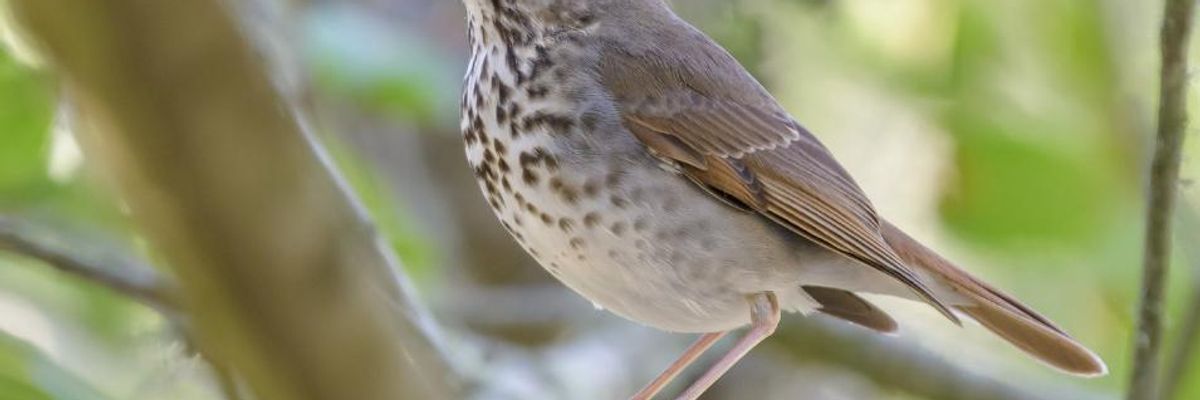The new report on nature's precipitous decline is... beyond alarming.
The announcement that the specter of extinction hangs over one million species dispels any possibility of saying, "The state of the earth can't be all that bad, can it?" That said, the Intergovernmental Science-Policy Platform on Biodiversity and Ecosystem Services (IPBES) gives us a lot to work with. Tucked in the release are hints of important tools to help us pivot away from this mess. Where do we go from here? The 100-plus scientists from 50 countries have done their job and now it's up to us--primed with our love of living things and of the special places that have enriched our souls and lives.
One message absent from the headlines is the prospect of ecological restoration; the assessment emphasizes the need to "conserve" and "preserve." Failing to underscore eco-restoration is, to me, a missed opportunity. The truth is that nature wants to heal herself, and will do so if given a chance or--better--a nudge; ecological systems self-organize, and all species from bacteria to grasses to beavers have a proclivity to create the conditions under which they will thrive. In my reporting I have encountered numerous examples of restored ecosystems and revived biodiversity. Most dramatic is the rehabilitation of China's Loess Plateau, a huge, multi-year World Bank-sponsored project in which an area the size of Belgium returned to vitality. Filmmaker John D. Liu's documentary work, shown in time-lapse, lets you watch a barren, dust-covered mountainside amass sturdy trees and turn a luxuriant green. Meanwhile, some 2.5 million people were lifted out of poverty.
"Nature wants to heal herself, and will do so if given a chance or--better--a nudge."
In interviews, Sir Bob Watson, the presiding IPBES Chair, states that biodiversity loss and climate change are intertwined. This is important, since various crises are often presented as separate, even competing, topics, contending for the same limited pool of funds and airtime. But while he referred to climate change's compounding stress on biodiversity, we can also acknowledge that solutions also build upon each other. In discussions of climate we have so far neglected the role of functioning ecosystems in climate regulation. Biodiversity and climate resilience go hand in hand. Ecological restoration thus not only supports habitat for a growing number of species, but also moderates climate.
A striking finding in the report was the destructive impact of agriculture on forests and other landscapes. This need not be the case. Depending on how it is done, growing food can be damaging to ecosystems and biodiversity--or it can heal landscapes and enhance biodiversity. Regenerative agriculture, a suite of approaches that focus on building soil and allying with natural processes, is highly productive and frequently more profitable because farmers aren't spending on inputs. Of the many examples of regenerative agriculture I've observed, one that stands out is a collaboration between ranchers and bird conservation organizations in Chihuahua, Mexico that is creating a biological corridor for endangered migratory grassland birds. The ranchers use holistic planned grazing, moving their cattle strategically, to revitalize the pastures. The land is now alive with birds and pollinating insects.
In response to the argument that farming in harmony with nature is not economical, I say we've got our numbers wrong. The IPBES authors agree. The report calls attention to a critical design flaw in our global economic model: nature is valued at zero. A standing forest that people enjoy and is home to wildlife does not contribute to the GDP. Once the trees are chopped down for lumber, it's deemed an economic positive. This makes no sense, since without stable ecosystems there is no economy.
"The report calls attention to a critical design flaw in our global economic model: nature is valued at zero."
The document targets the perverse incentives to degrade ecosystems that are baked into current economics and encourages new structures that reflect and account for the value of nature. Imagine if companies were rewarded for bolstering biodiversity rather than for yield or haul. All business decisions are driven by what it is we are managing for. Why not manage for an outcome that would benefit all?
The study properly emphasizes that nature is not just an assemblage of things, nor is it static. Rather, the collective species that comprise the natural world are dynamic and productive. Plants, animals, and microbes of all sorts are busy doing work: cleansing and cycling water; oxygenating air; providing sustenance up and down the food chain. Concerns about biodiversity have tended to focus on specific, charismatic species, which makes it easier to disengage. We may hear about, say, the plight of rhinos, feel a twinge of sadness and then go about our day. Appreciating that natural systems work as a whole, and how nature creates and sustains our land- and seascapes, helps us connect more deeply to the environment. I see this as the heart of the matter. Our personal experiences of nature--that inner leap when a Luna moth knocks at the window--are powerful and drive us to care. For I believe people are motivated by love more than fear. Helping nature thrive is not only good for our real economy, it nourishes our spirit.
It's a beautiful day in Vermont--long-awaited sunshine after more than a week of rain. For the first time this year I catch the trill of a Hermit Thrush, our state bird and cherished songster.
While writing I've been taking breaks to run down to the meadow to help my husband plant two pear trees. These are to honor my father, who is at the end of his life (pere being father in French). I feel a tenderness toward the fledgling plants, an attachment that feels personal. These spindly trees have entered my orbit of affection--that which I care about--an emblem of my own parent and the living planet that parents all of us.
